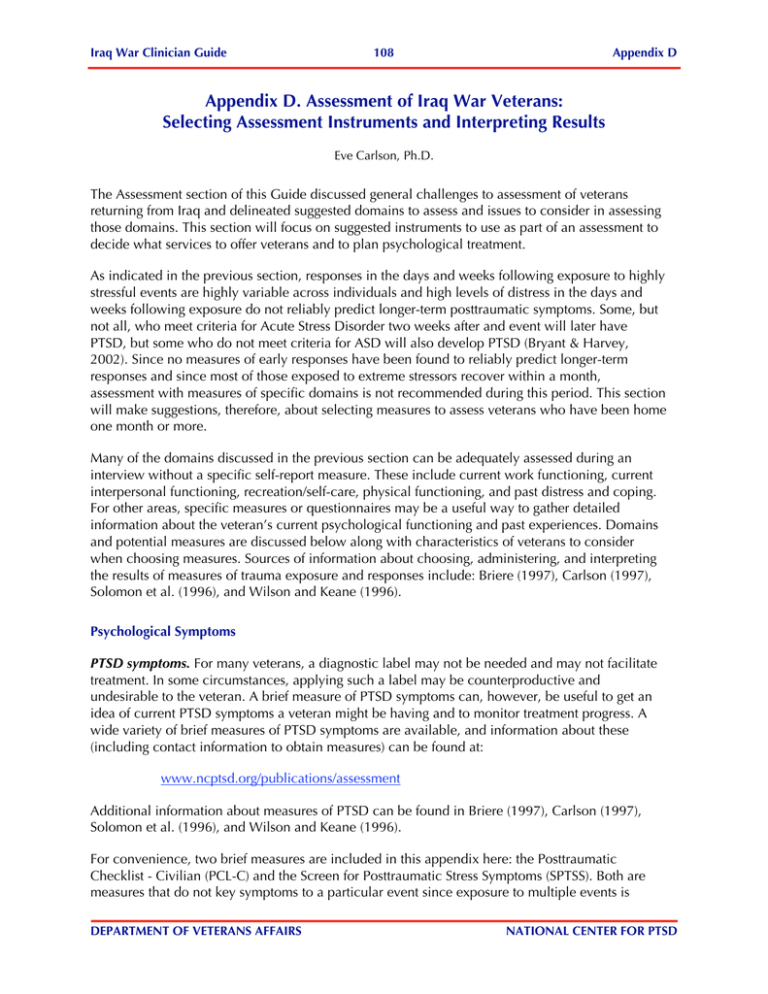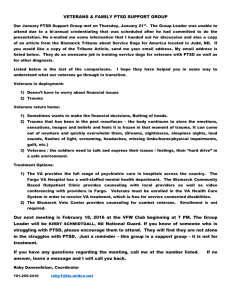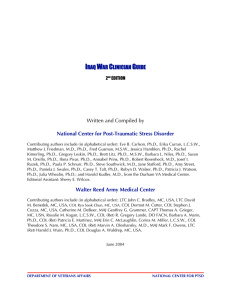Appendix D. Assessment of Iraq War Veterans:
advertisement

Iraq War Clinician Guide 108 Appendix D Appendix D. Assessment of Iraq War Veterans: Selecting Assessment Instruments and Interpreting Results Eve Carlson, Ph.D. The Assessment section of this Guide discussed general challenges to assessment of veterans returning from Iraq and delineated suggested domains to assess and issues to consider in assessing those domains. This section will focus on suggested instruments to use as part of an assessment to decide what services to offer veterans and to plan psychological treatment. As indicated in the previous section, responses in the days and weeks following exposure to highly stressful events are highly variable across individuals and high levels of distress in the days and weeks following exposure do not reliably predict longer-term posttraumatic symptoms. Some, but not all, who meet criteria for Acute Stress Disorder two weeks after and event will later have PTSD, but some who do not meet criteria for ASD will also develop PTSD (Bryant & Harvey, 2002). Since no measures of early responses have been found to reliably predict longer-term responses and since most of those exposed to extreme stressors recover within a month, assessment with measures of specific domains is not recommended during this period. This section will make suggestions, therefore, about selecting measures to assess veterans who have been home one month or more. Many of the domains discussed in the previous section can be adequately assessed during an interview without a specific self-report measure. These include current work functioning, current interpersonal functioning, recreation/self-care, physical functioning, and past distress and coping. For other areas, specific measures or questionnaires may be a useful way to gather detailed information about the veteran’s current psychological functioning and past experiences. Domains and potential measures are discussed below along with characteristics of veterans to consider when choosing measures. Sources of information about choosing, administering, and interpreting the results of measures of trauma exposure and responses include: Briere (1997), Carlson (1997), Solomon et al. (1996), and Wilson and Keane (1996). Psychological Symptoms PTSD symptoms. For many veterans, a diagnostic label may not be needed and may not facilitate treatment. In some circumstances, applying such a label may be counterproductive and undesirable to the veteran. A brief measure of PTSD symptoms can, however, be useful to get an idea of current PTSD symptoms a veteran might be having and to monitor treatment progress. A wide variety of brief measures of PTSD symptoms are available, and information about these (including contact information to obtain measures) can be found at: www.ncptsd.org/publications/assessment Additional information about measures of PTSD can be found in Briere (1997), Carlson (1997), Solomon et al. (1996), and Wilson and Keane (1996). For convenience, two brief measures are included in this appendix here: the Posttraumatic Checklist - Civilian (PCL-C) and the Screen for Posttraumatic Stress Symptoms (SPTSS). Both are measures that do not key symptoms to a particular event since exposure to multiple events is DEPARTMENT OF VETERANS AFFAIRS NATIONAL CENTER FOR PTSD Iraq War Clinician Guide 109 Appendix D common and it is not clear that people can assign symptoms to events with any accuracy or that symptoms are, in fact, uniquely associated with particular events. The PCL-C is recommended rather than the PCL-Military because it is important to assess veterans’ responses to military and non-military traumatic events when assessing for treatment purposes. The SPTSS may be useful with veterans who have less formal education because it has a very low reading level. It may also be useful for veterans who are reluctant to report distress because it inquires about the frequency of symptoms rather than the degree of distress they cause. If assignment of a diagnostic label is required or desired, the Clinician Administered PTSD Scale (CAPS) (Weathers, Keane, & Davidson, 2001) can be used. Detailed information about this structured interview and how to obtain it are available at: http://www.ncptsd.org/publications/assessment/ncinstruments.html Dissociation. Dissociative symptoms are very common in trauma survivors, and they may not be spontaneously reported. The Trauma-Related Dissociation Scale (Carlson & Waelde, 2000), a measure of dissociation, is included in this appendix. Depression. Depression is a very common comorbid condition in those with posttraumatic disorders. It may be secondary to PTSD or associated with aspects of traumatic events such as losses. The Beck Depression Inventory (BDI) – Short Form is a common brief measure of depression and is included in the appendix (Beck & Steer, 2000). This measure is also available for computerized administration via DHCP at VA Medical Centers. Traumatic grief. Screen for Complicated Grief is a brief measure of symptoms of traumatic grief and is included in this appendix. Further details about the construct this screen measures can be found in Section VI of this Guide. Alcohol use. Substance use is a common problem for those with PTSD, particularly alcohol abuse and dependence. The AUDIT (Goldman, Brown, & Christiansen, 2000) is a screen for alcohol use that is included in this appendix. Other domains to assess and suggested measures: Anger. Anger is a frequent problem for trauma survivors and outbursts of anger is a symptom of PTSD. If a veteran reports problems with anger, detailed assessment of that area may be useful. The State-Trait Anger Expression Inventory (STAX-I) is measure of anger and how it is expressed (Spielberger, 1988). This measure may be useful to assess vets, although it is important to note that it is not ideal to assess recent, post-trauma anger because its trait form assesses both pre-trauma and post-trauma anger and its state form assesses feelings at the time of the assessment (which may not representative of the entire post-trauma period). Guilt and shame. Guilt and shame are frequently issues for trauma survivors who feel distressed over what they did or did not do at the time of trauma. Kubany et al. (1995) have developed a measure of guilt that may be useful to assess those with clinical issues in that domain. DEPARTMENT OF VETERANS AFFAIRS NATIONAL CENTER FOR PTSD Iraq War Clinician Guide 110 Appendix D Relevant History Exposure to potentially traumatic events. Because exposure to previous traumatic stressors may affect response to traumatic stressors experienced in the military, it is important to broadly assess exposure to traumatic stressors. The Trauma History Screen (Carlson, 2002), a brief assessment tool that can be used for that purpose, is included in this appendix. Selected scales within the Deployment Risk and Resilience Inventory (DRRI; King, King, & Vogt, 2003) may be used as a vehicle to identify particular combat and other high magnitude and threatening experiences that were potentially traumatic. Because the level of non-traumatic stressors and the overall context in which exposure to traumatic stressors occurs may affect the response to high magnitude stressors, it is important to assess these elements. Several scales from the DRRI (e.g., concerns about life and family disruptions, difficult living and working environment, war-zone social support) may prove useful to gain a broader profile of the deployment experience. Copies of the individual DRRI measures, scoring guides, and a full manual describing instrument development may be obtained by contacting dawne.vogt@med.va.gov. For women veterans. Because women who serve in the military may be exposed to a number of traumatic stressors that are not assessed in combat measures, specific assessment of military stressors is often helpful for women veterans. Life Stressors Checklist (Wolfe & Kimerling, 1997) is provided in this appendix for this purpose. References Beck, A.T., & Steer, R.A. (2000). Beck Depression Inventory. In Task Force for the Handbook of Psychiatric Measures (Ed.), Handbook of psychiatric measures (pp. 519-522). Washington, DC: American Psychiatric Association. Briere, J. (1997). Psychological assessment of adult posttraumatic states. Washington, DC: American Psychological Association. Bryant, R.A., & Harvey, A.G. (2002). Acute Stress Disorder: A synthesis and critique. Psychological Bulletin, 128, 886-902. Carlson, E.B. (1997). Trauma assessments: A clinician’s guide. New York: Guilford Press. Carlson, E.B. (November, 2002). Challenges to assessing traumatic stress histories in complex trauma survivors. Paper presented at the Annual meeting of the International Society for Traumatic Stress Studies, Baltimore, MD. Carlson, E.B., & Waelde, L. (November, 2000). Preliminary psychometric properties of the Trauma Related Dissociation Scale. Paper presented at the Annual meeting of the International Society for Traumatic Stress Studies, San Antonio, TX. Goldman, M., Brown, S., & Christiansen, B. (2000). Alcohol Expectancy Questionnaire (AEQ). In Task Force for the Handbook of Psychiatric Measures (Ed.), Handbook of psychiatric measures (pp. 476-477). Washington, DC: American Psychiatric Association. King, D.W., King, L.A., & Vogt, D.S. (2003). Manual for the Deployment Risk and Resilience Inventory (DRRI): A collection of measures for studying deployment-related experiences in military veterans. Boston, MA: National Center for PTSD. Kubany, E.S., Abueg, F.R., Owens, J.A., Brennan, J.M., Kaplan, A.S., & Watson, S.B. (1995). Initial examination of a multidimensional model of trauma-related guilt: Applications to combat veterans and battered women. Journal of Psychopathology and Behavioral Assessment, 17, 353-376. DEPARTMENT OF VETERANS AFFAIRS NATIONAL CENTER FOR PTSD Iraq War Clinician Guide 111 Appendix D Solomon, S., Keane, T., Kaloupek, D., & Newman, E. (1996). Choosing self-report measures and structured interviews. In E. B. Carlson (Ed.), Trauma research methodology (pp. 56-81). Lutherville, MD: Sidran Press. Spielberger, C.D. (1988). Manual for the State-Trait Anger Expression Inventory: STAXI. Odessa, FL: Psychological Assessment Resources. Weathers, F.W., Keane, T.M., & Davidson, J.R.T. (2001). Clinician-Administered PTSD Scale: a review of the first ten years of research. Depression and Anxiety, 156, 132-156. Wilson, J.P., & Keane, T.M. (Eds.). (1996). Assessing psychological trauma and PTSD. New York: Guilford Press. Wolfe, J., & Kimerling, R. (1997). Gender issues in the assessment of PTSD. In J. Wilson & T. M. Keane (Eds.), Assessing psychological trauma and PTSD (pp. 192-238). New York: Guilford. DEPARTMENT OF VETERANS AFFAIRS NATIONAL CENTER FOR PTSD Iraq War Clinician Guide DEPARTMENT OF VETERANS AFFAIRS 112 Appendix D NATIONAL CENTER FOR PTSD Iraq War Clinician Guide DEPARTMENT OF VETERANS AFFAIRS 113 Appendix D NATIONAL CENTER FOR PTSD Iraq War Clinician Guide DEPARTMENT OF VETERANS AFFAIRS 114 Appendix D NATIONAL CENTER FOR PTSD Iraq War Clinician Guide DEPARTMENT OF VETERANS AFFAIRS 115 Appendix D NATIONAL CENTER FOR PTSD Iraq War Clinician Guide DEPARTMENT OF VETERANS AFFAIRS 116 Appendix D NATIONAL CENTER FOR PTSD Iraq War Clinician Guide DEPARTMENT OF VETERANS AFFAIRS 117 Appendix D NATIONAL CENTER FOR PTSD Iraq War Clinician Guide DEPARTMENT OF VETERANS AFFAIRS 118 Appendix D NATIONAL CENTER FOR PTSD Iraq War Clinician Guide DEPARTMENT OF VETERANS AFFAIRS 119 Appendix D NATIONAL CENTER FOR PTSD Iraq War Clinician Guide DEPARTMENT OF VETERANS AFFAIRS 120 Appendix D NATIONAL CENTER FOR PTSD Iraq War Clinician Guide DEPARTMENT OF VETERANS AFFAIRS 121 Appendix D NATIONAL CENTER FOR PTSD Iraq War Clinician Guide DEPARTMENT OF VETERANS AFFAIRS 122 Appendix D NATIONAL CENTER FOR PTSD Iraq War Clinician Guide DEPARTMENT OF VETERANS AFFAIRS 123 Appendix D NATIONAL CENTER FOR PTSD Iraq War Clinician Guide DEPARTMENT OF VETERANS AFFAIRS 124 Appendix D NATIONAL CENTER FOR PTSD Iraq War Clinician Guide DEPARTMENT OF VETERANS AFFAIRS 125 Appendix D NATIONAL CENTER FOR PTSD





